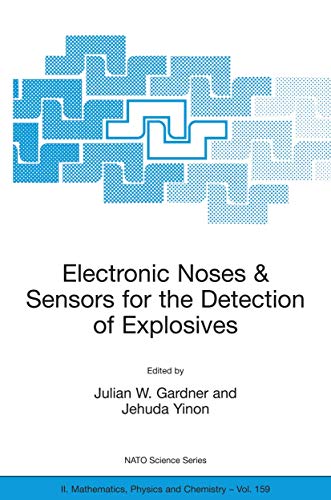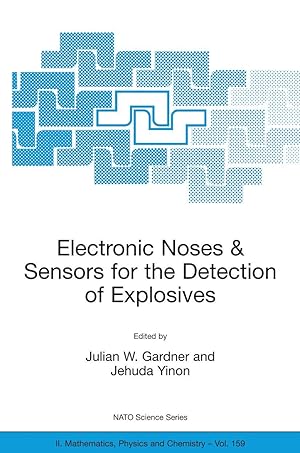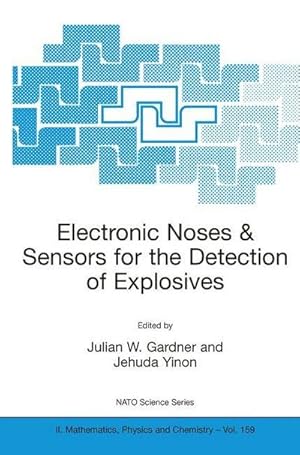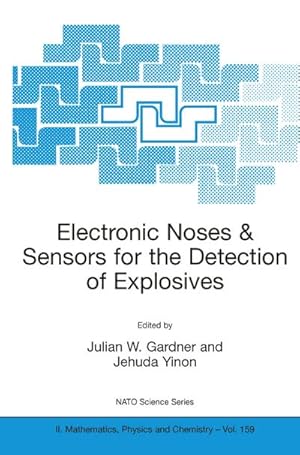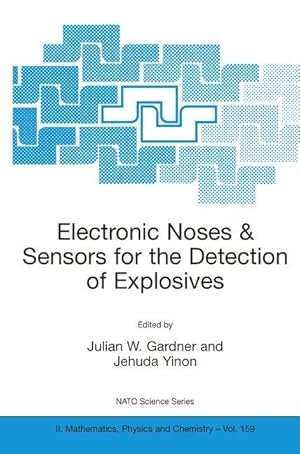explosives detection sensors electronic (28 Ergebnisse)
Suchfilter
Produktart
- Alle Product Types
- Bücher (28)
- Magazine & Zeitschriften (Keine weiteren Ergebnisse entsprechen dieser Verfeinerung)
- Comics (Keine weiteren Ergebnisse entsprechen dieser Verfeinerung)
- Noten (Keine weiteren Ergebnisse entsprechen dieser Verfeinerung)
- Kunst, Grafik & Poster (Keine weiteren Ergebnisse entsprechen dieser Verfeinerung)
- Fotografien (Keine weiteren Ergebnisse entsprechen dieser Verfeinerung)
- Karten (Keine weiteren Ergebnisse entsprechen dieser Verfeinerung)
- Manuskripte & Papierantiquitäten (Keine weiteren Ergebnisse entsprechen dieser Verfeinerung)
Zustand Mehr dazu
- Neu (25)
- Wie Neu, Sehr Gut oder Gut Bis Sehr Gut (1)
- Gut oder Befriedigend (2)
- Ausreichend oder Schlecht (Keine weiteren Ergebnisse entsprechen dieser Verfeinerung)
- Wie beschrieben (Keine weiteren Ergebnisse entsprechen dieser Verfeinerung)
Weitere Eigenschaften
- Erstausgabe (Keine weiteren Ergebnisse entsprechen dieser Verfeinerung)
- Signiert (Keine weiteren Ergebnisse entsprechen dieser Verfeinerung)
- Schutzumschlag (Keine weiteren Ergebnisse entsprechen dieser Verfeinerung)
- Angebotsfoto (10)
- Keine Print-on-Demand Angebote (20)
Sprache (1)
Preis
- Beliebiger Preis
- Weniger als EUR 20 (Keine weiteren Ergebnisse entsprechen dieser Verfeinerung)
- EUR 20 bis EUR 45 (Keine weiteren Ergebnisse entsprechen dieser Verfeinerung)
- Mehr als EUR 45
Gratisversand
- Kostenloser Versand nach USA (Keine weiteren Ergebnisse entsprechen dieser Verfeinerung)
Land des Verkäufers
Verkäuferbewertung
-
paperback. Zustand: Good. Connecting readers with great books since 1972! Used textbooks may not include companion materials such as access codes, etc. May have some wear or writing/highlighting. We ship orders daily and Customer Service is our top priority!
-
Zustand: New. 326 pp., paperback, NEW!! - If you are reading this, this item is actually (physically) in our stock and ready for shipment once ordered. We are not bookjackers. Buyer is responsible for any additional duties, taxes, or fees required by recipient's country.
-
Electronic Noses & Sensors for the Detection of Explosives (NATO Science Series II: Mathematics, Physics and Chemistry, 159)
Buch 241 von 241: NATO Science Series II: Mathematics, Physics and ChemistryAnbieter: Phatpocket Limited, Waltham Abbey, HERTS, Vereinigtes Königreich
EUR 133,20
EUR 12,11 für den Versand von Vereinigtes Königreich nach USAAnzahl: 1 verfügbar
In den WarenkorbZustand: Good. Your purchase helps support Sri Lankan Children's Charity 'The Rainbow Centre'. Ex-library, so some stamps and wear, but in good overall condition. Our donations to The Rainbow Centre have helped provide an education and a safe haven to hundreds of children who live in appalling conditions.
-
Explosives Detection: Sensors, Electronic Systems and Data Processing (NATO Science for Peace and Security Series B: Physics and Biophysics)
Buch 29 von 32: NATO Science for Peace and Security Series B: Physics and BiophysicsAnbieter: Lucky's Textbooks, Dallas, TX, USA
EUR 158,99
EUR 3,45 für den Versand innerhalb von/der USAAnzahl: Mehr als 20 verfügbar
In den WarenkorbZustand: New.
-
Explosives Detection: Sensors, Electronic Systems and Data Processing (NATO Science for Peace and Security Series B: Physics and Biophysics)
Buch 29 von 32: NATO Science for Peace and Security Series B: Physics and BiophysicsAnbieter: Lucky's Textbooks, Dallas, TX, USA
EUR 159,40
EUR 3,45 für den Versand innerhalb von/der USAAnzahl: Mehr als 20 verfügbar
In den WarenkorbZustand: New.
-
Explosives Detection: Sensors, Electronic Systems and Data Processing (NATO Science for Peace and Security Series B: Physics and Biophysics)
Buch 29 von 32: NATO Science for Peace and Security Series B: Physics and BiophysicsAnbieter: Ria Christie Collections, Uxbridge, Vereinigtes Königreich
EUR 157,19
EUR 13,63 für den Versand von Vereinigtes Königreich nach USAAnzahl: Mehr als 20 verfügbar
In den WarenkorbZustand: New. In.
-
Explosives Detection: Sensors, Electronic Systems and Data Processing (NATO Science for Peace and Security Series B: Physics and Biophysics)
Buch 29 von 32: NATO Science for Peace and Security Series B: Physics and BiophysicsAnbieter: Ria Christie Collections, Uxbridge, Vereinigtes Königreich
EUR 163,16
EUR 13,63 für den Versand von Vereinigtes Königreich nach USAAnzahl: Mehr als 20 verfügbar
In den WarenkorbZustand: New. In.
-
Taschenbuch. Zustand: Neu. Explosives Detection | Sensors, Electronic Systems and Data Processing | Lorenzo Capineri (u. a.) | Taschenbuch | xiii | Englisch | 2021 | Springer | EAN 9789402417319 | Verantwortliche Person für die EU: Springer Verlag GmbH, Tiergartenstr. 17, 69121 Heidelberg, juergen[dot]hartmann[at]springer[dot]com | Anbieter: preigu.
-
Taschenbuch. Zustand: Neu. Druck auf Anfrage Neuware - Printed after ordering - This volume presents selected contributions from the 'Advanced Research Workshop on Explosives Detection' hosted by the Department of Information Engineering of the University of Florence, Italy in 2018. The main goal of the workshop was to find out how Science for Peace and Security projects in the field of Explosives Detection contribute to the development and/or refinement of scientific and technical knowledge and competencies. The findings of the workshop, presented in the last section of the book, determine future actions and direction of the SPS Programme in the field of explosives detection and management.The NATO Science for Peace and Security (SPS) Programme, promotes dialogue and practical cooperation between NATO member states and partner nations based on scientific research, technological innovation and knowledge exchange. Several initiatives were launched in the field of explosive detection and clearance, as part of NATO's enhanced role in the international fight against terrorism. Experts and scientists from NATO members and partner countries have been brought together in multi-year projects, within the framework of the SPS Programme, to cooperate in the scientific research in explosive detection field, developing new technologies and methods to be implemented in order to detect explosive substances in different contexts.
-
Explosives Detection : Sensors, Electronic Systems and Data Processing
Buch 29 von 32: NATO Science for Peace and Security Series B: Physics and BiophysicsVerlag: Springer Netherlands, Springer Netherlands, 2020
ISBN 10: 9402417281 ISBN 13: 9789402417289
Sprache: Englisch
Anbieter: AHA-BUCH GmbH, Einbeck, Deutschland
Buch. Zustand: Neu. Druck auf Anfrage Neuware - Printed after ordering - This volume presents selected contributions from the 'Advanced Research Workshop on Explosives Detection' hosted by the Department of Information Engineering of the University of Florence, Italy in 2018. The main goal of the workshop was to find out how Science for Peace and Security projects in the field of Explosives Detection contribute to the development and/or refinement of scientific and technical knowledge and competencies. The findings of the workshop, presented in the last section of the book, determine future actions and direction of the SPS Programme in the field of explosives detection and management.The NATO Science for Peace and Security (SPS) Programme, promotes dialogue and practical cooperation between NATO member states and partner nations based on scientific research, technological innovation and knowledge exchange. Several initiatives were launched in the field of explosive detection and clearance, as part of NATO's enhanced role in the international fight against terrorism. Experts and scientists from NATO members and partner countries have been brought together in multi-year projects, within the framework of the SPS Programme, to cooperate in the scientific research in explosive detection field, developing new technologies and methods to be implemented in order to detect explosive substances in different contexts.
-
Explosives Detection: Sensors, Electronic Systems and Data Processing
Buch 29 von 32: NATO Science for Peace and Security Series B: Physics and BiophysicsAnbieter: Revaluation Books, Exeter, Vereinigtes Königreich
EUR 234,30
EUR 11,38 für den Versand von Vereinigtes Königreich nach USAAnzahl: 2 verfügbar
In den WarenkorbPaperback. Zustand: Brand New. 344 pages. 9.25x6.10x0.82 inches. In Stock.
-
Explosives Detection: Sensors, Electronic Systems and Data Processing
Buch 29 von 32: NATO Science for Peace and Security Series B: Physics and BiophysicsAnbieter: Revaluation Books, Exeter, Vereinigtes Königreich
EUR 236,32
EUR 14,22 für den Versand von Vereinigtes Königreich nach USAAnzahl: 2 verfügbar
In den WarenkorbHardcover. Zustand: Brand New. 348 pages. 9.25x6.10x0.94 inches. In Stock.
-
Electronic Noses and Sensors for the Detection of Explosives (Nato Science Series II: Mathematics, Physics and Chemistry)
Buch 241 von 241: NATO Science Series II: Mathematics, Physics and ChemistryAnbieter: Mispah books, Redhill, SURRE, Vereinigtes Königreich
EUR 277,75
EUR 28,45 für den Versand von Vereinigtes Königreich nach USAAnzahl: 1 verfügbar
In den WarenkorbPaperback. Zustand: Like New. Like New. book.
-
Electronic Noses & Sensors for the Detection of Explosives (NATO Science Series II: Mathematics, Physics and Chemistry, 159)
Buch 241 von 241: NATO Science Series II: Mathematics, Physics and ChemistryAnbieter: Ria Christie Collections, Uxbridge, Vereinigtes Königreich
EUR 297,82
EUR 13,63 für den Versand von Vereinigtes Königreich nach USAAnzahl: Mehr als 20 verfügbar
In den WarenkorbZustand: New. In.
-
Electronic Noses & Sensors for the Detection of Explosives (NATO Science Series II: Mathematics, Physics and Chemistry, 159)
Buch 241 von 241: NATO Science Series II: Mathematics, Physics and ChemistryAnbieter: Ria Christie Collections, Uxbridge, Vereinigtes Königreich
EUR 297,82
EUR 13,63 für den Versand von Vereinigtes Königreich nach USAAnzahl: Mehr als 20 verfügbar
In den WarenkorbZustand: New. In.
-
Electronic Noses & Sensors for the Detection of Explosives
Buch 241 von 241: NATO Science Series II: Mathematics, Physics and ChemistryAnbieter: moluna, Greven, Deutschland
EUR 336,82
EUR 48,99 für den Versand von Deutschland nach USAAnzahl: Mehr als 20 verfügbar
In den WarenkorbZustand: New. Proceedings of the NATO Advanced Research Workshop, held in Warwick, Coventry, U.K., 30 September-3 October 2003 This book examines both the potential application of electronic nose technology, and the current state of development of chemical sensors.
-
Electronic Noses & Sensors for the Detection of Explosives
Buch 241 von 241: NATO Science Series II: Mathematics, Physics and ChemistryVerlag: Springer Netherlands, Springer Netherlands, 2004
ISBN 10: 1402023189 ISBN 13: 9781402023187
Sprache: Englisch
Anbieter: AHA-BUCH GmbH, Einbeck, Deutschland
Taschenbuch. Zustand: Neu. Druck auf Anfrage Neuware - Printed after ordering - This book examines both the potential application of electronic nose technology, and the current state of development of chemical sensors for the detection of vapours from explosives, such as those used in landmines. The two fields have developed, somewhat in parallel, over the past decade and so one of the purposes of this workshop, on which the book is based, was to bring together scientists from the two fields in order to challenge the two communities and, mutually, stimulate both fields.It begins with a review of the basic principles of an electronic nose and explores possible ways in which the detection limit of conventional electronic nose technology can be reduced to the level required for the trace levels observed for many explosive materials. Next are reviews of the use of several different types of solid-state chemical sensors: polymer-based sensors, i.e. chemiluminescent, fluorescent and optical, to detect explosive materials; metal oxide semiconducting resistive sensors; and then electrochemical sensors. Next, different pattern recognition techniques are presented to enhance the performance of chemical sensors. Then biological systems are considered as a possible blue-print for chemical sensing. The biology can be employed either to understand the way insects locate odorant sources, or to understand the signal processing neural pathways. Next is a discussion of some of the new types of electronic noses; namely, a fast GC column with a SAW detector and a micromechanical sensor. Finally, the important issues of sampling technologies and the design of the microfluidic systems are considered. In particular, the use of pre-concentrators and solid phase micro extractors to boost the vapour concentration before it is introduced to the chemical sensor or electronic nose.
-
Buch. Zustand: Neu. Neuware - This book examines both the potential application of electronic nose technology, and the current state of development of chemical sensors for the detection of vapours from explosives, such as those used in landmines. The two fields have developed, somewhat in parallel, over the past decade and so one of the purposes of this workshop, on which the book is based, was to bring together scientists from the two fields in order to challenge the two communities and, mutually, stimulate both fields.It begins with a review of the basic principles of an electronic nose and explores possible ways in which the detection limit of conventional electronic nose technology can be reduced to the level required for the trace levels observed for many explosive materials. Next are reviews of the use of several different types of solid-state chemical sensors: polymer-based sensors, i.e. chemiluminescent, fluorescent and optical, to detect explosive materials; metal oxide semiconducting resistive sensors; and then electrochemical sensors. Next, different pattern recognition techniques are presented to enhance the performance of chemical sensors. Then biological systems are considered as a possible blue-print for chemical sensing. The biology can be employed either to understand the way insects locate odorant sources, or to understand the signal processing neural pathways. Next is a discussion of some of the new types of electronic noses; namely, a fast GC column with a SAW detector and a micromechanical sensor. Finally, the important issues of sampling technologies and the design of the microfluidic systems are considered. In particular, the use of pre-concentrators and solid phase micro extractors to boost the vapour concentration before it is introduced to the chemical sensor or electronic nose.
-
Electronic Noses & Sensors for the Detection of Explosives
Buch 241 von 241: NATO Science Series II: Mathematics, Physics and ChemistryVerlag: Springer Netherlands Aug 2004, 2004
ISBN 10: 1402023189 ISBN 13: 9781402023187
Sprache: Englisch
Anbieter: BuchWeltWeit Ludwig Meier e.K., Bergisch Gladbach, Deutschland
Taschenbuch. Zustand: Neu. This item is printed on demand - it takes 3-4 days longer - Neuware -This book examines both the potential application of electronic nose technology, and the current state of development of chemical sensors for the detection of vapours from explosives, such as those used in landmines. The two fields have developed, somewhat in parallel, over the past decade and so one of the purposes of this workshop, on which the book is based, was to bring together scientists from the two fields in order to challenge the two communities and, mutually, stimulate both fields.It begins with a review of the basic principles of an electronic nose and explores possible ways in which the detection limit of conventional electronic nose technology can be reduced to the level required for the trace levels observed for many explosive materials. Next are reviews of the use of several different types of solid-state chemical sensors: polymer-based sensors, i.e. chemiluminescent, fluorescent and optical, to detect explosive materials; metal oxide semiconducting resistive sensors; and then electrochemical sensors. Next, different pattern recognition techniques are presented to enhance the performance of chemical sensors. Then biological systems are considered as a possible blue-print for chemical sensing. The biology can be employed either to understand the way insects locate odorant sources, or to understand the signal processing neural pathways. Next is a discussion of some of the new types of electronic noses; namely, a fast GC column with a SAW detector and a micromechanical sensor. Finally, the important issues of sampling technologies and the design of the microfluidic systems are considered. In particular, the use of pre-concentrators and solid phase micro extractors to boost the vapour concentration before it is introduced to the chemical sensor or electronic nose. 328 pp. Englisch.
-
Explosives Detection: Sensors, Electronic Systems and Data Processing (NATO Science for Peace and Security Series B: Physics and Biophysics)
Buch 29 von 32: NATO Science for Peace and Security Series B: Physics and BiophysicsAnbieter: Majestic Books, Hounslow, Vereinigtes Königreich
EUR 204,63
EUR 7,40 für den Versand von Vereinigtes Königreich nach USAAnzahl: 4 verfügbar
In den WarenkorbZustand: New. Print on Demand.
-
Buch. Zustand: Neu. Explosives Detection | Sensors, Electronic Systems and Data Processing | Lorenzo Capineri (u. a.) | Buch | xiii | Englisch | 2020 | Springer | EAN 9789402417289 | Verantwortliche Person für die EU: Springer Verlag GmbH, Tiergartenstr. 17, 69121 Heidelberg, juergen[dot]hartmann[at]springer[dot]com | Anbieter: preigu Print on Demand.
-
Zustand: New. PRINT ON DEMAND.
-
Explosives Detection: Sensors, Electronic Systems and Data Processing (NATO Science for Peace and Security Series B: Physics and Biophysics)
Buch 29 von 32: NATO Science for Peace and Security Series B: Physics and BiophysicsAnbieter: Majestic Books, Hounslow, Vereinigtes Königreich
EUR 219,01
EUR 7,40 für den Versand von Vereinigtes Königreich nach USAAnzahl: 4 verfügbar
In den WarenkorbZustand: New. Print on Demand pp. 344.
-
Zustand: New. PRINT ON DEMAND pp. 344.
-
Electronic Noses & Sensors for the Detection of Explosives
Buch 241 von 241: NATO Science Series II: Mathematics, Physics and ChemistryAnbieter: moluna, Greven, Deutschland
EUR 267,86
EUR 48,99 für den Versand von Deutschland nach USAAnzahl: Mehr als 20 verfügbar
In den WarenkorbZustand: New. Dieser Artikel ist ein Print on Demand Artikel und wird nach Ihrer Bestellung fuer Sie gedruckt. Proceedings of the NATO Advanced Research Workshop, held in Warwick, Coventry, U.K., 30 September-3 October 2003 This book examines both the potential application of electronic nose technology, and the current state of development of chemical sensors.
-
Electronic Noses & Sensors for the Detection of Explosives
Buch 241 von 241: NATO Science Series II: Mathematics, Physics and ChemistryVerlag: Springer Netherlands, Springer Netherlands Aug 2004, 2004
ISBN 10: 1402023189 ISBN 13: 9781402023187
Sprache: Englisch
Anbieter: buchversandmimpf2000, Emtmannsberg, BAYE, Deutschland
Taschenbuch. Zustand: Neu. This item is printed on demand - Print on Demand Titel. Neuware -This book examines both the potential application of electronic nose technology, and the current state of development of chemical sensors for the detection of vapours from explosives, such as those used in landmines. The two fields have developed, somewhat in parallel, over the past decade and so one of the purposes of this workshop, on which the book is based, was to bring together scientists from the two fields in order to challenge the two communities and, mutually, stimulate both fields. It begins with a review of the basic principles of an electronic nose and explores possible ways in which the detection limit of conventional electronic nose technology can be reduced to the level required for the trace levels observed for many explosive materials. Next are reviews of the use of several different types of solid-state chemical sensors: polymer-based sensors, i.e. chemiluminescent, fluorescent and optical, to detect explosive materials; metal oxide semiconducting resistive sensors; and then electrochemical sensors. Next, different pattern recognition techniques are presented to enhance the performance of chemical sensors. Then biological systems are considered as a possible blue-print for chemical sensing. The biology can be employed either to understand the way insects locate odorant sources, or to understand the signal processing neural pathways. Next is a discussion of some of the new types of electronic noses; namely, a fast GC column with a SAW detector and a micromechanical sensor. Finally, the important issues of sampling technologies and the design of the microfluidic systems are considered. In particular, the use of pre-concentrators and solid phase micro extractors to boost the vapour concentration before it is introduced to the chemical sensor or electronic nose.Springer Verlag GmbH, Tiergartenstr. 17, 69121 Heidelberg 328 pp. Englisch.



